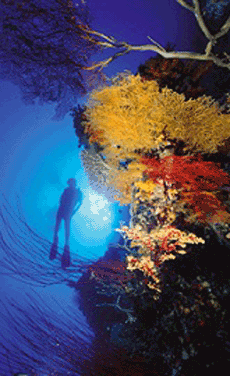![]() Heart Reef, Whitsundays, Qld Heart Reef, Whitsundays, Qld

![]()
![]()
|
Location: Queensland east coast
The Great Barrier Reef is one of the largest and most significant reef systems in the world, comprising some 3,400 individual reefs, including 760 fringing reefs, which range in size from under 1ha to over 10,000ha and vary in shape to provide the most spectacular marine scenery on earth. It includes the world's most extensive stretch of coral reef and is teeming with marine life, all of which is easily accessible to see and experience from a variety of towns and islands along the Queensland coast between Bundaberg in the south to the tip of Cape York in the north.
The Great Barrier Reef extends for more than 2,000km off the east coast of Australia, from just south of the Tropic of Capricorn to the coastal waters of Papua New Guinea. The reef system, extending to Papua New Guinea, There are approximately 300 coral cays, including 213 un-vegetated cays, 43 vegetated cays and 44 low wooded islands. There are also 618 continental islands which were once part of the mainland.
The form and structure of the individual reefs show great variety. Two main classes may be defined: platform or patch reefs, resulting from radial growth; and wall reefs, resulting from elongated growth, often in areas of strong water currents. There are also many fringing reefs where the reef growth is established on sub-tidal rock of the mainland coast or continental islands).
Water circulation is very complex, governed by properties of the Coral Sea, land run-off, evaporation, the south-east trade winds, forced upwellings due to strong tidal currents in narrow reef passages and coastal waters including mangroves. Tides are generally semi-diurnal with diurnal inequality towards the north, becoming almost diurnal in Torres Strait. The maximum tidal range is about 3m along most of the coast, although increasing to 6 to 9m in the Broad Sound area between 21 degrees and 23 degrees S. Water is vertically well-mixed for most of the year with stratification occurring due to freshwater input during January to April. Freshwater run-off can be very localised and significant physical and biological effects may be expected.
![]()
There are over 1,500 species of fish, 400 species of coral, 4,000 species of mollusc and 242 species of bird within the park, plus a great diversity of sponges, anemones, marine worms and crustaceans. The site includes major feeding grounds for dugong. Several cetaceans are present, including humpback whale, minke whale and killer orca whale. Dolphins include bottlenose, Irrawaddy Orcaella brevirotris and Indo-Pacific humpbacks. Offshore, spinner dolphin are also occasionally seen. There are nesting grounds of world significance for green turtle and loggerheads, and habitat for four other species of marine turtle.
The Great Barrier Reef, and in particular the northern sector, is important in the historic and contemporary culture of the Aboriginal and Torres Strait Islander groups of the coastal areas of north-east Australia. This contemporary use of and association with the Marine Park plays an important role in the maintenance of their cultures and there is a strong spiritual connection with the ocean and its inhabitants). Little systematic archaeological study has been done but it is known that there are large, important Aboriginal and Torres Strait Islander sites on a number of the islands. Some notable examples occur on Lizard and Hinchinbrook Islands and on Stanley, Cliff and Clack Islands in the vicinity of Cape Melville (14°S) where there are spectacular galleries of rock paintings.
![]()
About 30 wrecks of historic importance are known to exist in the area. One of the earliest, the wreck of HMS Pandora dating from 1791, lies near the reef in the northern sector to which it gave its name. The hazards of navigation in the Great Barrier Reef resulted in the construction of a large number of lighthouses, some of which have particular historical importance. The lighthouses at Lady Elliott Island (1866) and North Reef Island (1878) still operate and are fine examples of 19th century riveted steel plate construction).
The Great Barrier Reef is an area of remarkable biological diversity and beauty on the north-eastern coast of Australia. It contains the world's largest collection of coral reefs, with some 400 types of coral, 1,500 species of fish and 4,000 types of mollusc. It is an area of great scientific value and also provides a habitat for many threatened species including green turtle and dugong.
View Larger Map
|